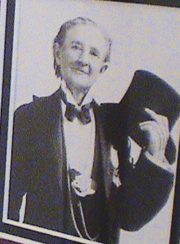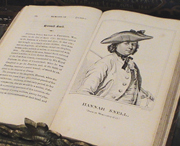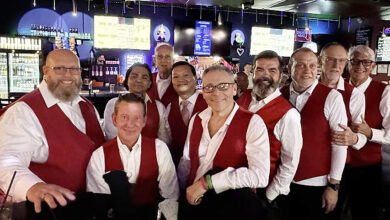The Houston Transgender Archive
Transgender history becomes alive and personal.
Feature and photos by Brandon Wolf
 Visitors can pick up 150-year-old newspapers, thumb through rare books, and hold priceless memorabilia in their hands.
Visitors can pick up 150-year-old newspapers, thumb through rare books, and hold priceless memorabilia in their hands.
“We have a hands-on policy here at the new Houston Transgender Archive,” says docent Christan Williams. “We want people who are transgenders to be able to walk into a place that’s about them and be able to immediately connect with thousands of years of rich history. We have focused on people who violated cultural norms, stepped outside the box, and dared to create something new.
“The point in history that we are at today is because of those who challenged the notions of gender,” states Williams. “We’re not just interested in transsexual history. Our goal is to tell the story of gender in our society and the conflict that gender can inspire for people who exhibit atypical gender expression.”

Because transgenders have lived without a sense of history as a people for so long, the Houston Transgender Archive actively searches out and acquires transgender historical items. A History Committee continues to establish contacts with rare book and document dealers, antique dealers, eBay and other online auctions, and specialty stores throughout the world. “We’ve told them to contact us if they acquire something they think is even remotely of interest to us,” Williams explains.
Currently, the archive holdings include transgender statues from diverse cultures such as China, Africa, and Europe; transgender magazines back to 1750; original newspapers reporting transgender history back to 1825; rare transgender books back to the 1600s; original transgender photos back to the pre-Civil War era; and other transgender artifacts back as far as the Roman Empire.
No other collection of transgender history similar to the Houston Transgender Archive is known to exist anywhere. Sponsored by the Transgender Foundation of America, this archive creates an educational experience that is absolutely unique. The collection offers students, community members, and supporters an up-close-and-personal opportunity to access centuries of information about the transgender community.
18 Random Things You Probably Never Knew About Transgenders
When Williams talked with OutSmart about the Houston Transgender Archive and gave us a tour of the impressive collection, she pointed out numerous exhibits of interest and explained the exciting and little known history behind them.
• Mary Walker.
A wall display honors Mary Walker, a Civil War soldier and surgeon. There are first-day-of-issue postage stamps honoring Walker, photos of her dressed as a male, and a letter written to her. She received the Presidential Medal of Honor and other distinctions, but they were all reversed after she was arrested and imprisoned several times for cross dressing. She refused to send back the medal. President Jimmy Carter reinstated her Medal of Honor; now she is commemorated by a postage stamp, and an aircraft carrier bears her name.

• Quan Yin. High on a display case rests the head of a statue of the Hindu/Buddhist male saint Avalokite vara, who was associated with justice and wrath. Over time, he became more associated with compassion and was feminized. He transitioned into a female saint named Quan Yin. The statue from which the head was taken is several hundred years old and is from India. It is from a period halfway through the male-to-female transition.

A tiny statue of Bacchus rests on a shelf. Bacchus is often represented as a burly bearded man, but in Roman mythology it’s very much an androgynous figure. In this version of Bacchus, the statuette is clearly female. She dances, beating cymbals decked with ribbons.
• Gay Marriage. An 1842 newspaper is pulled from a stack. It contains a story about two Millerite (Seventh-Day Adventist) women who entered into what they called domestic partnership. They took each other for better or for worse. They explained how they were in love and discussed their dowries. They planned to continue to live with each other.
• Civil War-Era Newspaper. Newspapers from the Civil War period are removed from the stack. Several articles discuss women who enlisted and served as soldiers. The stories relate their battlefield experiences and the effects on their lives after their gender became known.
• Nazi Book Burnings. On the walls are framed front pages of The New York Times with particular articles emphasized. The stories are about the sacking of Dr. Magnus Hirschfield’s gender-studies clinic by the Nazis. They stripped the clinic and burned his scholarly books. They seized client rosters of Hirschfield’s transsexual patients, arrested them, and sent them to death camps.
• Pre-Stonewall Riot. In a display case are two ashtrays from Gene Compton’s Cafeteria, where the first queer uprising took place in 1966. Policemen in the Tenderloin District of San Francisco regularly arrested cross dressers, who were hauled to jail to be raped or forced to sexually service an officer in the cafeteria bathroom. One night, policemen came into the cafeteria to make arrests, but the cross dressers threw coffee, ashtrays, chairs, and anything else they could find at the officers. The riot lasted for 24 hours, and the cafeteria was nearly destroyed. Today a historical plaque marks the site.
• Christine Jorgensen.
Several items of memorabilia celebrate Christine Jorgensen, the first American transsexual to use mass media to create a national conversation about gender and sexuality. On one wall is a framed newspaper advertisement for Jorgensen’s nightclub act at the Latin Quarter. On another wall is a framed Sunday newspaper supplement in which she tells her story to American readers. The supplement is accompanied by a personal letter from Jorgensen in which she expresses her appreciation: “I am glad to be able to share my story, because I now understand that thousands of other people suffer from the same problem I do. I want to reach out to them and let them know there is someone else, and that someone else was able to do something about it.” There are also several autographed pictures of Jorgensen, the proofs from Jorgensen newspaper articles, and copies of the vinyl record album, Christine Jorgensen Reveals. One picture of Jorgensen shows her with the man she hoped to marry, but they were denied a marriage license.

• Transgenders in the Media. Vertical filing boxes contain photographs, media articles, newsletters, and medical digests. Law reports describe transgender legal ›
issues, such as name and sex marker changes. Publications from Galveston’s gender-treatment clinic explain to families how to deal with gender variant behavior. A medical journal from France discusses gender and chromosomes. A magazine from 1750 profiles Hannah Snell, a female-to-male transgender.
• Freak Shows. A decades-old handbill, advertising a traveling freak show, hangs on a wall. It features a half man/half woman described in Jerry Springer-style sexualized and sensationalized language.
• Rare Books.
A collection of rare books includes an original Magnus Hirschfield book that somehow survived the Nazi destruction. Another book is autographed by the first transgender politician in Japan, who heard about the Houston collection and donated it. An original copy of Dr. Harry Benjamin’s The Transsexual Phenomenon rests on a shelf.

• Queen Christina. A 100-year-old, stylized print of Sweden’s Queen Christina hangs on a wall, displayed with a coin bearing her likeness. In the print, Christina is shown being presented to the pope, asking for permission to live in Rome. When the request was granted, Christina abdicated her throne in order to live openly as a man in the Italian city.
• Deborah Sampson. An 1827 regional newspaper article is framed and mounted on a wall. It features an article about Deborah Sampson, a female who dressed as a male, fought battles, and became a hero. Because she was not a biological male, she was denied a military pension.
• Renée Richards. An autographed picture of transsexual tennis player Renée Richards is also mounted and framed. Richards often was subjected to the ire of other female competitors, who complained that playing against Richards was tantamount to playing against a male.
• Sandy O’Daniel. A pair of boots worn by Sandy O’Daniel honors “the spiritual father of Houston female-to-male transsexuals.”
• Coccinelle. Upstairs at the center, a huge mounted movie poster advertises a 1962 Italian film, I, Don Giovanni della Costa Azzura . The cast includes European male-to-female transsexual Coccinelle. The actress was the first transsexual in Europe to successfully gain a marriage license. She also founded several social service organizations for transgenders.
• Myra Breckenridge. Another mounted movie poster advertises the controversial 1970 film Myra Breckenridge. It is accompanied by autographs from the book’s author, Gore Vidal, and the film’s screenwriter, Rex Reed. A publicity photo groups together the stars—John Huston, Raquel Welch, Mae West, and Rex Reed.
A Houston Transgender Pioneer
Josephine Tittsworth has been involved in local transgender organizing for nearly three decades. She has witnessed transgender history first-hand and helped to create it. Tittsworth recalls: “The history of the transgender community in Houston is rich and full of diversity. In 1981, I collaborated with Melanie Rudd and Peggy Rudd to organize the first Tri-Ess support group in Houston [Tri-Delta Chapter] for heterosexual cross dressers. Later it split into the Gulf Coast Transgender Club [GCTC] and Tau Chi [the Tri-Ess group]. TATS [Texas Association for Transsexual Support] formed after GCTC.
“Peggy Rudd and Rene Fenner founded the Houston Transgender Unity Banquet back when the groups were arguing and competing for members. I served a total of five years as the co-chair of the Houston Transgender Unity Committee. We took the banquet from the small banquet hall to the large ballroom and started the concept of corporate sponsorships. Today, the Houston Transgender Unity Banquet is the largest single night event in the world for the transgender community. Houston is the only metro area in the United States today where all the transgender groups cooperate together yet independently.”
The Link Between Misogyny and Queerphobia
Jo Collier, a research assistant at a local library, heads up the History Committee for the Houston Transgender Archive. She reflected on why she has volunteered for this role: “It’s important to me that we are collecting information, not simply about transgender individuals, but about people who stepped outside the boundaries of what their culture considered acceptable for their gender. It is important to recognize that a great deal of the trouble that the queer community deals with has its origins in misogyny [hatred of women], which is why LGBT Studies are linked to the Women’s Studies programs at academic institutions. This isn’t a new idea, linking misogyny and queerphobia, but you would think it was. I remember talking to one man and hearing him say, with a sneer, something about Intro to LGBT Studies being a part of Women’s Studies, like it was something beneath him. I didn’t say it, because I was sober, but I was thinking—and if I’d had a couple in me I’d have said it—“You’re a part of the problem, dude!”
Collier notes that the Archive Committee has begun the cataloging process and has begun work on a collection development policy. The committee is also drafting plans for an online searchable transgender archive. A sampling of the digitized items that will be available in this online archive can currently be viewed at http://tgctr.org/archive.shtml . Individuals interested in joining this committee can sign up at the center; Collier invites members of the community to “journey with us.”
Visiting the Houston Transgender Archive
The Houston Transgender Archive is small in size, but focused in nature. Its holdings are world class, and their presentation is superb. The archive is housed at the beautiful Transgender Foundation of America Center located at 713 Fargo here in Houston. The center opens on weekdays at 1 p.m. and closes at 4 p.m. To schedule a personalized guided tour with an archive docent, please contact the center at 713/520-8586. Entrance to the center is free of charge, but donations are always appreciated.
Brandon Wolf also writes about Annise Parker and preserving Houston’s LGBT history in this issue of OutSmart magazine.










